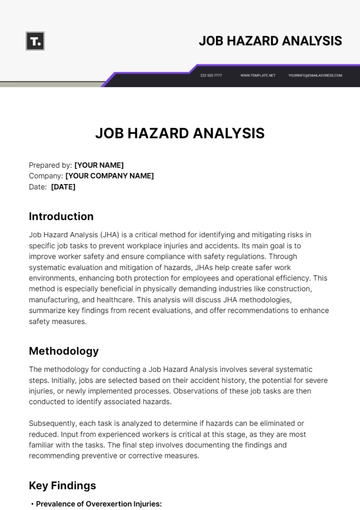Free Job Safety Analysis Report

Prepared By: [Your Name]
Position: Safety Officer
Reviewed By: Michael Johnson
Position: Operations Manager
Date: June 5, 2050
I. Introduction
Job Safety Analysis (JSA) is a vital component of occupational health and safety programs. It involves a structured approach to identifying potential hazards associated with job tasks and developing strategies to mitigate them. This report outlines the JSA process, identifies hazards, and recommends controls to ensure a safe working environment.
II. Purpose
The primary purpose of this Job Safety Analysis is to systematically examine the tasks required for a particular job, identify potential hazards, and implement measures to prevent accidents or injuries. This ensures compliance with occupational health standards while promoting a culture of safety.
III. Scope
This report focuses on a specific job task within the organization, providing a detailed analysis of potential safety issues and recommended preventive measures. The scope includes task identification, hazard identification, and implementation of controls.
3.1 Task Identification
Job Task: Construction Worker on a Building Site
The job of a construction worker involves several essential steps to ensure safety and efficiency on the site. These steps are outlined in the table below:
Step | Description |
|---|---|
Step 1: Initialization | Prepare the work area by gathering tools and conducting a safety briefing. |
Step 2: Operation | Perform construction tasks, operate machinery, and follow safety protocols. |
Step 3: Shutdown | Secure tools shut down equipment, and inspect the site for hazards. |
3.2 Hazard Identification
Task Step | Potential Hazards |
|---|---|
Step 1: Initialization | Slips and trips due to a cluttered workspace |
Step 2: Operation | Exposure to hazardous materials, such as chemicals and dust |
Step 3: Shutdown | Equipment malfunction leading to injury or failure to secure tools |
3.3 Control Measures
Based on the identified hazards, the following control measures are recommended to mitigate potential risks:
Task Step | Control Measures |
|---|---|
Initialization | Ensure the workspace is clear of clutter to prevent slips and trips by conducting regular housekeeping checks. |
Operation |
|
Shutdown |
|
IV. Recommendations
To enhance workplace safety, it is recommended that:
Regular training sessions on safety protocols be conducted for all employees, focusing on hazard recognition and proper PPE usage.
Safety audits and inspections occur frequently to identify new hazards and reinforce safety compliance.
An incident reporting system be established to improve response times and track safety concerns effectively.
V. Emergency Procedures
In case of an emergency, the following procedures should be followed:
Emergency Procedures | Details |
|---|---|
Emergency Contact Numbers | Emergency Services: 911 |
Evacuation Routes | Evacuation routes are marked on-site, leading to the designated assembly point at the northeast corner of the site. |
First Aid Procedures |
|
VI. Conclusion
The Job Safety Analysis is a fundamental tool to ensure occupational safety and health standards. By identifying potential hazards and implementing effective controls, organizations can significantly reduce the risk of work-related injuries and foster a safer working environment.
- 100% Customizable, free editor
- Access 1 Million+ Templates, photo’s & graphics
- Download or share as a template
- Click and replace photos, graphics, text, backgrounds
- Resize, crop, AI write & more
- Access advanced editor
Ensure workplace safety with the Job Safety Analysis Report Template from Template.net. This fully editable and customizable template provides a structured approach to identifying and mitigating potential hazards in various job tasks. Designed for safety professionals, it allows you to tailor the content to meet specific project requirements. Streamline your safety reporting process while ensuring compliance and promoting a safer work environment for all employees with this comprehensive tool.





























